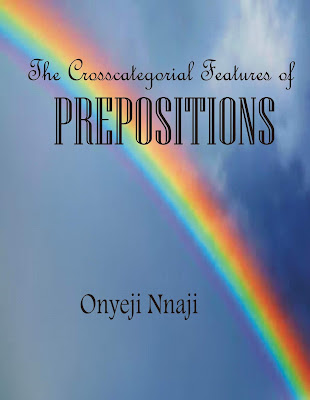THE PASSIVE SENTENCE - Onyeji Nnaji
Before discussing the ways in which passive
sentences are formed, it is expedient to explain the meaning of voice because, passive is one of the voices of verbs. Voice refers to the verb form which
shows whether a transitive verb acts or is acted upon.
These situations give rise to two voices -Active and Passive. The active voice, which is more common, shows
when the subject does the action of the verb. For example:
-
Jude collected the money.
Here, Jude
performs the action. It is placed in the subjective position. The passive voice
shows a situation where the subject is acted upon. It suffers the action
indicated by the verb. Example:
- The money was collected by Ali.
English sentences
can begin with the subject or object. This is determined by the voice a
sentence takes. Voice is the form a verb takes to indicate whether a person or
thing does something or something has been done to a person or a thing. A voice
describes the relationship between the action (or state) that the verb
expresses and the participants identified by its arguments (subject, object
etc). For easy understanding of this explanation given above, we illustrate it
in the following sentences:
Ude killed the
goat
The goat was
killed by Ude.
In grammar, we do
not consider the true test of the statement. The cases of grammar are being
judged by considering the position in which they appear. Considering the first
sentence illustrated above, Ude, having taking the rightful subjective position
(as a doer and as agent), is considered as the grammatical subject. As the doer
of the action, Ude occupies this position as a rightful or the logical subject.
Semantically and logically, Ude occupies its rightful position as the performer
of the action. However, in the second sentence, the position of the logical
subject (doer) shifts to that of the target or undergoer of the action, the
goat. As a result, the goat in this sentence is the grammatical subject (the
undergoer) of the action performed by Ude, the logical subject.
English has two forms of voice. They
are:
Active voice
Passive voice
The Active Voice
A voice is said to be active when the subject
is the agent or doer of the action. In the active voice, the subject of the
sentence performs the action or causes the happening denoted by the verb.
Active voice is used in a clause whose subject expresses agent of the main
verb. That is, the subject does the action assigned by the verb. So in active
voice, the agent is marked grammatical subject. Consider the following
sentences:
Ojo killed a lion.
We saw the train.
They cut the tree.
The Passive Voice
A verb is said to be passive when something has been done to the subject. That is, the grammatical subject, the person or thing that is affected by the action of the verb, takes up the subject position. The passive voice is employed in a clause whose subject expresses the theme or patient of the verb. That is, it undergoes an action or has its state changed. In the passive voice, the grammatical subject of the verb is the recipient (not the doer) of the action indicated by the verb. The following sentences illustrate the passive voice:
A lion was killed by
Ojo.
The train was seen by
us.
The tree was cut by
them.
The following
sentences below justify the logic in active and passive transformations:
Active
|
passive
|
Ayo cuts a tree.
|
A tree is cut
by Ayo.
|
Ayo is cutting
a tree.
|
A tree is being
cut by Ayo.
|
Ayo has cut a
tree.
|
A tree has been
cut by Ayo.
|
Ayo cut a tree.
|
A tree was cut
by Ayo.
|
Ayo has been
cutting a tree.
|
A tree has been
being cut by Ayo.
|
Ayo had cut a
tree.
|
A tree had been
cut by Ayo.
|
Ayo had been
cutting a tree.
|
A tree had been
being cut by Ayo.
|
Ayo was cutting
a tree.
|
A tree was
being cut by Ayo.
|
Ayo will cut a
tree.
|
A tree will be
cut by Ayo.
|
Ayo will be cutting a tree.
|
A tree will be
being cut by Ayo.
|
Basic Rules For
Changing Active Into Passive
In changing the
active voice into the passive, the following rules are followed:
The object of the
verb in the active voice becomes the subject of the verb in the passive slot.
Ojo killed a
lion. (active).
A lion was killed
by Ojo. (passive)
The subject of
the verb in the active voice becomes the object in the passive voice,
obligatorily preceded by the preposition by.
Consider the example shown above.
The main verb is
changed into past participle form and it is preceded by the right form of the
verb be in the passive voice. Examples are seen
in:
Amadi wrote a
letter. (active)
A letter was
written by Amadi. (passive)
The verbs that
have double objects always go with either of the objects (preferably the
personal objects). The preferable object occupies the subject position and the
other object is retained as an object. As Das (2010) puts it, this is called
Retained Object. Examples of such sentences are seen below:
Our teacher gave us
textbooks. (passive)
(I.O) (D.O)
We were given textbooks (by our
teacher) (passive I)
Textbooks were given to us. (Passive
II
The preposition by is always placed to govern the recipient of the
action in the passive slot.
Verb Patterns of
Passive Voice
The verb Patterns
in Passive voice are expressed in the table below:
Tense
|
Verb ‘be’
|
Past participle
of the main verb
|
||
Simple present
and past
|
am
|
saw
|
||
are
|
seen
|
|||
is
|
gave
|
|||
was
|
beaten
|
|||
were
|
killed
|
|||
Continuous
|
am
|
seen
|
||
are
|
seen
|
|||
Is
|
given
|
|||
was
|
beaten
|
|||
were
|
killed
|
|||
Perfect
|
has
|
caged
|
||
have
|
caught
|
|||
had
|
judged
|
|||
Future
|
shall
|
constructed
|
||
Will
|
Washed
|
Pronoun Change in Passive Voice
In the passive voice, there are
changes in pronouns. study this table.
Subjective form
|
Objective form
|
I
|
Me
|
We
|
Us
|
You
|
You
|
He
|
Him
|
She
|
Her
|
They
|
Them
|
Active and
passive voice in different sentences
In the imperative
sentences, if the verb in the active voice expressed orders, requests, advice
etc, the verb ‘let’ usually precede the passive
voice and the verb ‘be’ is placed before the
past participle of the main verb. On the other hand, if the sentences begin
with ‘please’ in active voice, the expression, ‘you requested to’ is used in the passive voice. These
are exemplified in the table below:
Active
|
passive
|
Do this job.
|
Let the job be done.
|
Close the chapter.
|
Let the chapter be closed.
|
Ask the tailor to come.
|
Let the tailor be asked to come.
|
Keep your promise.
|
Your promise should be kept.
|
Cut your hair.
|
your hair should be cut.
|
Please keep your items well.
|
You are requested to keep your items well.
|
Please see him.
|
You are requested to see him.
|
Please do not take a beer.
|
You are requested not to take beer.
|
Go back there.
|
You are requested to go back there.
|
Come back again.
|
You are requested to come back again.
|
It should be noted
well, that let may be used in both active and passive voice. ‘Let’ takes the objective type of pronouns me, us, him, her, them. ‘Let’
may be replaced by ‘may be allowed’ in the
passive voice.
Active
|
Passive
|
Let him bring
the goods.
|
Let the goods
be brought by him.
|
Let us forget
the past.
|
Let the past be
forgotten (by us).
|
Let them leave.
|
They may be
allowed to leave.
|
In interrogative
sentences, the passive voice keeps its interrogative form as it is in the
active voice. If the interrogative sentence begins with the auxiliary verb do, the process of changing is convenient by changing
it into assertive first and then into interrogative. But if the interrogative
sentence begins with any other auxiliary verb or a Wh-word,
it can be directly changed into passive. Consider the following interrogative
sentences:
Yes-no questions
(by placing the helping verb first)
Active: Do you see
the doctor?
Passive: Is the
doctor seen by you?
Active: Did you
see the car?
Passive: Was the
car seen by you?
Active: Has she
cooked it?
Passive: Has it
been cooked by him?
Active: Have you
studied the theory?
Passive: Has the
theory been studied by you?
Wh-questions (by
placing the Wh-word first)
Active: Who told
you?
Passive: by whom
were you told that?
Active: Whom did
you call?
Passive: Who was
called by you?
Active: What do
you need?
Passive: What is
needed by you?
Active: Why did
the mother shout at you?
Passive: Why were
you shouted at by the mother?
Active: Which bag
do you want?
Passive: Which
bag is wanted by you?
Active: How did
you see it?
Passive: How was
it seen by you?
Negative
sentences (placing not before the past
participle of the verb)
Active: We do not
eat snail.
Passive: Snail is
not eaten by us.
Active: Oke did
not tell lies.
Passive: Lies
were not told by Oke.
Active: Father
has not brought the gift.
Passive: The gift
has not been brought by father.
Active: Has he
not seen the children?
Passive: Have not
the children seen by him.
Verbs That Can Be Passivized In English
Ideally, it is only the transitive
verbs that can undergo passivization in English. The reason is because they are
the only verbs which transfer their actions to the noun or the pronoun. Such
nouns in the objective case are those that will be reversed to form the passive
subjects. Intransitive, therefore, cannot be passivized since they do not have
the grammatical feature of transferring their actions to the object, but,
rather have their actions remaining in them.
However, there are some intransitive
verbs that can undergo passivization in some cases. When an intransitive can be
converted transitively, having a cognate object,
it can be converted into the passive voice. Consider the following examples:
Active
|
Passive
|
Nduka slept
a sleep.
|
A sleep was slept by Nduka.
|
The children played
a rough play.
|
A rough play was played by the children.
|
The soldier fought
a good fight.
|
A good fight was fought by the soldier.
|
Edo ran
a race.
|
A race
was run by Edo.
|
The old man dreamt
a horrible dream.
|
A horrible
dream was dreamt by the old man.
|
An intransitive verb can also be
used passively when used causatively. Examples are shown below:
Active: The hockey walked
the horse after the race.
Passive: The horse was walked
by the hockey after the race.
Active: The boys have
stood the board against the wall.
Passive: The board has
been stood against the wall.
The Passive Voice With Double Objects
Some sentences can yield two passive
forms especially such sentences with two complements and indirect object (I.O)
and a direct object (D.O). In such a construction, either the direct or
indirect object can become the subject of the passive sentence. As explained
earlier, the indirect object or the personal object is preferred for the
subject. Another object in the sentence is retained. Hence, it is called
Retained Object. Examples are shown below:
Active: The manager
granted us the permission.
Passive: The permission
was granted us by the manager.
We were granted permission by the manager.
Active: The company
issued him a participatory certificate.
Passive: A participatory
certificate was issued to him by the company.
He was issued a participatory certificate by
the company.
Active: The teacher gave
me a pencil.
Passive: A pencil was
given to me by the teacher.
I was given a pencil by the teacher.
Active: Kunle bought me
a good dictionary.
Passive: A good
dictionary was bought by Kunle.
I was bought a good dictionary by Kunle.
Active: They offered him
a nice opportunity.
Passive: A nice
opportunity was offered to him.
He was offered a nice opportunity by them.
Active: Mr. Ojo teaches us
English.
Passive: We were taught
English by Mr. Ojo
English is taught (to) us by Mr. Ojo
Active: Agnes sent him a
message.
Passive: He was sent a
message by Agnes
A message was sent (to) him by Agnes.
Active: They handed him
a flower.
Passive: He was handed a
flower by them
A flower was handed (to) him by them.
Active: The receptionist
offered me a sear.
Passive: I was offered a
seat by the receptionist.
A seat was offered (to) me by the
receptionist.
Active: The landlord
gave us a quit notice.
Passive: We were given a
quit notice by the landlord.
A quit notice was given to us by the
landlord.
Passives with Reflexive Objects
Reflexive objects are formed with ‘self’. They cannot be changed into subject. Examples
are:
Active: She saw herself.
Passive: She was seen by
herself.
Note that we cannot say: Herself was
seen by her. As Das (2010) pointed out, this passive with reflexive object is
not good English. The active form should be preferred. In affirmation to this,
Fowler stated that it is a familiar process. But it sometimes leads to bad
grammar, false idiom or clumsiness.
Forming passives with infinitives (to + verb)
In forming passives with infinitives
changes occur as illustrated in the following sentences:
Active: There are lots
of things to say.
Passive: There are lots
of things to be said.
Active: There is no time
to waste.
Passive: There is no
time to be wasted.
Active: We have to
admit that.
Passive: That as to
be admitted by us.
Active: We are to
make necessary changes
Passive: Necessary
changes have to be made by us.
Verbs followed by objects + bare
infinitives as follow:
Active: We saw her go to
the library. (to before go
is omitted)
Passive: She was seen to
go to the library. ( to is used).
Active: Amobi made us
cry. (‘to’ is omitted)
Passive: We were made to
cry by Amobi. (‘To’ is added)
Forming passives with the stative verbs (doing/seeing) etc
Active: I don’t like
people informing me of what I know.
Passive: I don’t like being
informed of what I know.
Active: Women do not
like people searching their bags.
Passive: Women do not
like their bags being searched by people.
Active: Managers hate people keeping them waiting.
Passive: Managers hate being
kept waiting.
Note here that the subjects remain unchanged in this kind of constructions. Also, when the action is important, not the doer, or the doer is unknown, the object or the doer with ‘by’ is understood. So in this case, the preposition by may be omitted. Examples are:
Active
|
Passive
|
He has lost his
money.
|
His money has
been lost.
|
They’ve stolen
his car.
|
His car has
been stolen.
|
Someone praised
him then.
|
He was praised
then.
|
The engineers
are constructing the bridges.
|
The bridges are
being constructed.
|
Passive
Voice with ‘that Clause’
Passive voice is
something used to introduce a ‘that clause’. Consider the following examples:
Active: We said that he
is a lawyer.
Passive: It is said that
he is a lawyer.
Active: They believed
that he told the truth.
Passive: It is believed
that he told the truth.
Active: The lecturers
may point out that he copied from John.
Passive: It may be
pointed out that he copied from John.
Active: He admits that
he has deceived the boy.
Passive: It is admitted
that he has deceived the boy.
Active: it proved that
he had apologised to the teacher.
Passive: it was proved
that he had apologised to the teacher.
It should be noted here, that the
subject of the passive voice in ‘that clause’ are mainly the non-personal
pronoun ‘it’.






.jpeg)
Comments
Post a Comment